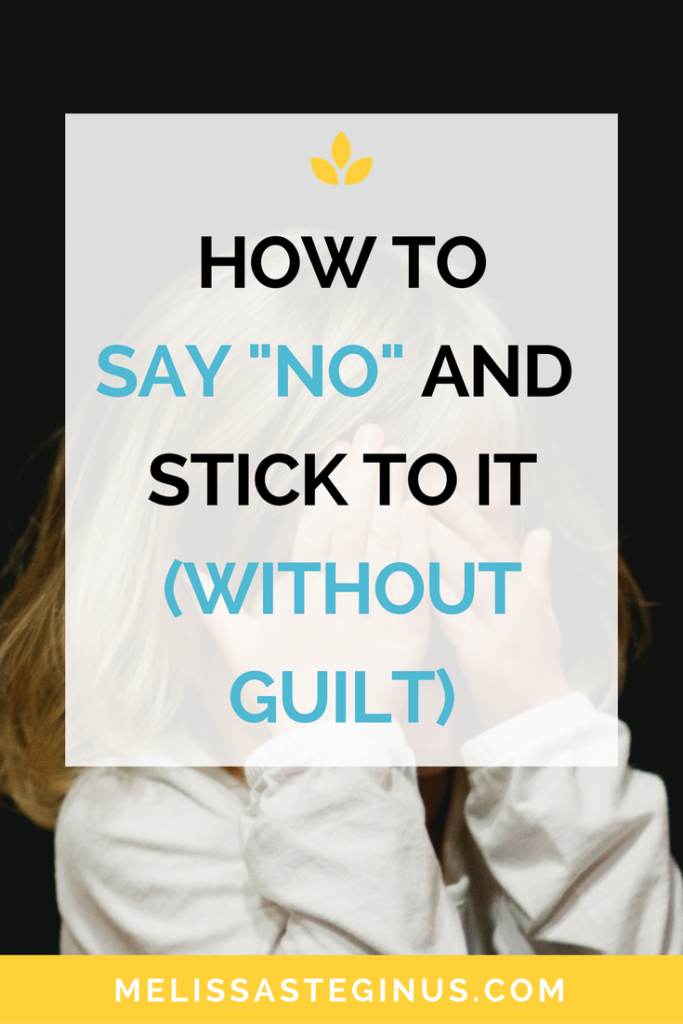Imagine your life with less stress. You’re not always on the go. You’re not constantly trying to please everyone else. You have more time and energy. You’re doing what’s important to you.
Sounds pretty great, huh? Yes?
Actually, I’m saying “no.” That’s right—I said it! And I think you’d benefit from saying “no” too. A lot.

There’s a time and a place for “yes,” but it’s often overused. It’s time to start harnessing the power of “no.”
It’s time to do your best at what you can do rather than dig yourself into a hole by trying to tackle everything at once.
Saying “no” to the unimportant stuff frees you up to invest in the important stuff. In the wise words of programmer and writer, Derek Sivers, “If you’re not saying ‘hell yeah’ about something, say ‘no.’”
Say “no” to “yes” so that you can invest yourself in the “hell yeah” stuff! Click To Tweet
So, what does this mean, exactly? There’s a lot of talk about saying “no,” but what does that look like for you? I’m talking about setting boundaries. Parameters. Guidelines.
When you put together a puzzle, where do you start? The edges. The same is true when creating a schedule or making major decisions. Ask yourself, “What are my parameters?”
The boundaries you put in place reflect the priorities you set. And your priorities determine your direction.
Set (excessively) specific boundaries
Setting a boundary is like making a promise to yourself. Make your promise with specific ground rules so that you can know how to apply (and adjust) your boundaries.
Know why you want to set a certain boundary. What change do you want to see?
Maybe you’re limiting work hours to spend more time with family. Or you’re laying off junk food and hitting the gym to become healthier.
Wanting to make a change is important. Keep things simple so that you can start working on making that change.
Know the purpose behind any boundary you set. Then break things down.
When are you going to actively set or practice putting your boundary in place? What will it look like? Who will support you and keep you accountable?
Example: “I won’t work overtime.”
“Overtime” might mean different things to different people. Do you want to avoid working in the evenings? On weekends? Over a certain number of hours per week? Clarify what your boundary looks like for you.
Example: “I will only drink on special occasions.”
How would you define a special occasion? Birthdays, promotions, and retirement probably count. Sometimes the Friday evening after a tough week at work also qualifies!
Even if you do plan to only drink on special occasions, are you having a glass of wine or a few shots of whiskey? How many “special occasions” are you limited to per month? Year?
Break it down so you know exactly where to drawn your line.
Know your specific guidelines so you can take out the guesswork. Focus your energy on sticking to your boundaries rather than struggling to answer questions as you go.
Publicize your priorities
Staying accountable to your boundaries is much easier when others know you have them. Sometimes it isn’t enough to keep them to yourself.
When I dove into writing my first book, I kept my goals and boundaries to myself. In doing so, my initial excitement quickly turned into isolation. I’d reject friends’ offers to meet up without giving them a proper explanation. They were hurt, and I was left resenting this gigantic project I’d taken on.
When I finally outlined specific writing guidelines for myself (i.e. writing days, word count goals, etc.), I also set writing boundaries. When I told others about those boundaries, I reopened the doors to our friendship. I couldn’t spend time with them on these days for this reason, but what about this day instead?
Publicizing your boundaries and offering alternative solutions when your line is crossed keeps you accountable and brings others on board.
If a friend asks you out for a drink when you’re trying to stay sober, let them know that boundary. Ditch the bar and go for coffee, walk in the park, or check out a yoga class. You’re never obligated to share why you have your boundary in place, but you might find it helpful to be prepared with some alternative activities.
After enough time, people will “get the hint,” so to speak. During my book-writing process, friends learned not to schedule anything with me on my writing days (quite possibly because they were sick of me saying no and talking about my book). They saw what I was willing and not willing to do (and when), which meant I spent less time both explaining my boundaries and trying to schedule around them.
Stick to your rules
No one transforms their lives or themselves overnight. It’s about starting small and building up.
Often, when we set boundaries, we expect to see immediate change. You’ve made things simple and specific, told your surrounding circles, and are well on your way to personal transformation!
Well, kind of. You’ve set yourself up for success. Now it’s about moving forward. But… how?
1. Root in your purpose
Once you define your boundary and its ground rules, you set a bar by which to measure whether or not you will do something. Does it honour your boundary or will it cross the line you’ve set in place?
Example: You want to eat less junk food to lose weight and be healthier.
Super! What does your diet consist of? How are you improving your health?
Example: You want to stop working overtime so you can spend more time with your family.
Great. What do your work hours look like now? Are you spending your free time with your partner and kids? Are you honouring your reason for setting that boundary in the first place?
You’re going to be tempted to overstep your boundaries. Stuff comes up. Work calls you in for overtime. Cookies call your name from the kitchen cupboard.
Sticking to your boundaries means you will keep saying “no” when you desperately crave a tasty, chocolate-covered “YES!”
Always come back to your “why.” If you know the purpose of your boundary, you’re more likely to make (and keep) it a priority.
2. Build healthy habits that reflect your priorities
When you’re struggling to stick to a boundary you’ve set, offer yourself some kind of anchor or incentive. This will help you turn your boundary into a priority.
In the words of James Clear, “Creating the habit of setting priorities is crucial to staying consistent and seeing success.”
Example: let’s say your boundary is that you will not drink alcohol for one month. Build a healthy habit for every time you crave a drink.
“When I want to drink alcohol, I will ________ instead.”
Fill in the blank with a healthy alternative: drink a glass of water, make a fruit smoothie, go for a walk, or call a friend or accountability partner.
Example: if you’re determined to work only 40 hours per week, create healthy incentives.
“When I’m off work at 5pm each day, I can go to my 6pm yoga class.”
“When I work a 40-hour week, my partner and I can do _____ on the weekend.”
Keep your anchor or incentive healthy and related to your boundary.
3. Create a personal action plan
Boundaries provide parameters, which create structure. Planning implements some of that external structure into the boundary itself.
Start with you. When you set a boundary, what will it require of you?
If you’re moving to a certain diet, create meal plans. Buy only the ingredients you’ll need. Get rid of unhealthy snacks. Know what you can eat when you go to a restaurant. Know what you’ll need to avoid.
Once you know how your boundary will affect you, think of others involved. Who will this affect? Who will you need to inform? Who can keep you accountable?
If you’re setting work-related boundaries, you may need to set a meeting, make phone calls, or fire off a few emails to inform colleagues, clients, or your employer. Let people know what kinds of things you will and will no longer be taking on.
If you’re self-employed, you might want to get in on the /now page movement. This is simply adding a page to your website explaining what you’re focusing on and what invitation or opportunities you’re likely to decline.
Whatever your plan, make it specific and share it with others.
4. Practice saying “no” to the small stuff
There are countless distractions and temptations competing for your attention. There will always be others attempting to push their priorities on you.
Knowing your priorities and what’s important to you is the secret to saying “no” consistently and confidently. Click To Tweet
Providing your purpose and/or alternative activities also gives you a socially acceptable excuse to say “no” when you need to.
Tim Ferriss, author of the Four-Hour Workweek, suggests that there are numberless ways to say “no” without even opening your mouth. With specific regard to business and entrepreneurship:
01. Don’t answer calls from unrecognized phone numbers
02. Don’t e-mail first thing in the morning or last thing at night
03. Do not over-communicate with low-profit, high-maintenance customers
In other words, say “no” to the energy-sucking and time-wasting tasks that don’t benefit you. Don’t invest more into others’ priorities than you do your own.
Setting and prioritizing your boundaries keeps you saying “no” to the unimportant stuff so you can say “hell yeah!” to the right stuff. Your stuff.
All it takes is a two-letter word.
Get the newsletter
Twice a month, I send tips and tools for time, task, and energy management, work-life wellness, and more.



